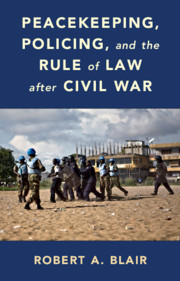Book contents
- Frontmatter
- Contents
- List of Figures
- List of Tables
- Acknowledgements
- List of Abbreviations
- 1 Introduction
- 2 History of UN Intervention and the Rule of Law after Civil War
- 3 Conceptual Framework: Civil War through a Legal Lens
- 4 Theoretical Framework: Restoring the Rule of Law after Civil War
- 5 Cross-national Evidence: UN Intervention and the Rule of Law across Africa
- 6 Sub-national Evidence I: The Rule of Law and Its Discontents in Liberia
- 7 Sub-national Evidence II: Evaluating the UN from the Bottom-Up
- 8 Sub-national Evidence III: UN Intervention and the Rule of Law in Liberia
- 9 Implications for Africa and beyond
- Bibliography
- Index
2 - History of UN Intervention and the Rule of Law after Civil War
Published online by Cambridge University Press: 09 November 2020
- Frontmatter
- Contents
- List of Figures
- List of Tables
- Acknowledgements
- List of Abbreviations
- 1 Introduction
- 2 History of UN Intervention and the Rule of Law after Civil War
- 3 Conceptual Framework: Civil War through a Legal Lens
- 4 Theoretical Framework: Restoring the Rule of Law after Civil War
- 5 Cross-national Evidence: UN Intervention and the Rule of Law across Africa
- 6 Sub-national Evidence I: The Rule of Law and Its Discontents in Liberia
- 7 Sub-national Evidence II: Evaluating the UN from the Bottom-Up
- 8 Sub-national Evidence III: UN Intervention and the Rule of Law in Liberia
- 9 Implications for Africa and beyond
- Bibliography
- Index
Summary
As UN missions have grown in scope and complexity, restoring the rule of law has become increasingly central to their mandates and exit strategies, which hinge on the transfer of legal and political power to legitimate, effective security and justice institutions. UN missions now regularly assume responsibility for drafting laws and lobbying for their passage; revising constitutions; training judges, prosecutors, and police officers; building courthouses, police stations, and prisons; monitoring extrajudicial punishments, arbitrary arrests, indefinite detentions, and other abuses; assisting with criminal investigations and prosecutions; improving coordination both between and among state and non-state authorities; and more generally elevating the role of the state as a purveyor of security and justice. All of these activities are designed in part to foster the rule of law. This chapter traces how the rule of law became so central to UN mandates around the world, providing empirical examples along the way to illuminate the UN's approach to rule-of-law reform in practice.
Keywords
- Type
- Chapter
- Information
- Publisher: Cambridge University PressPrint publication year: 2020



